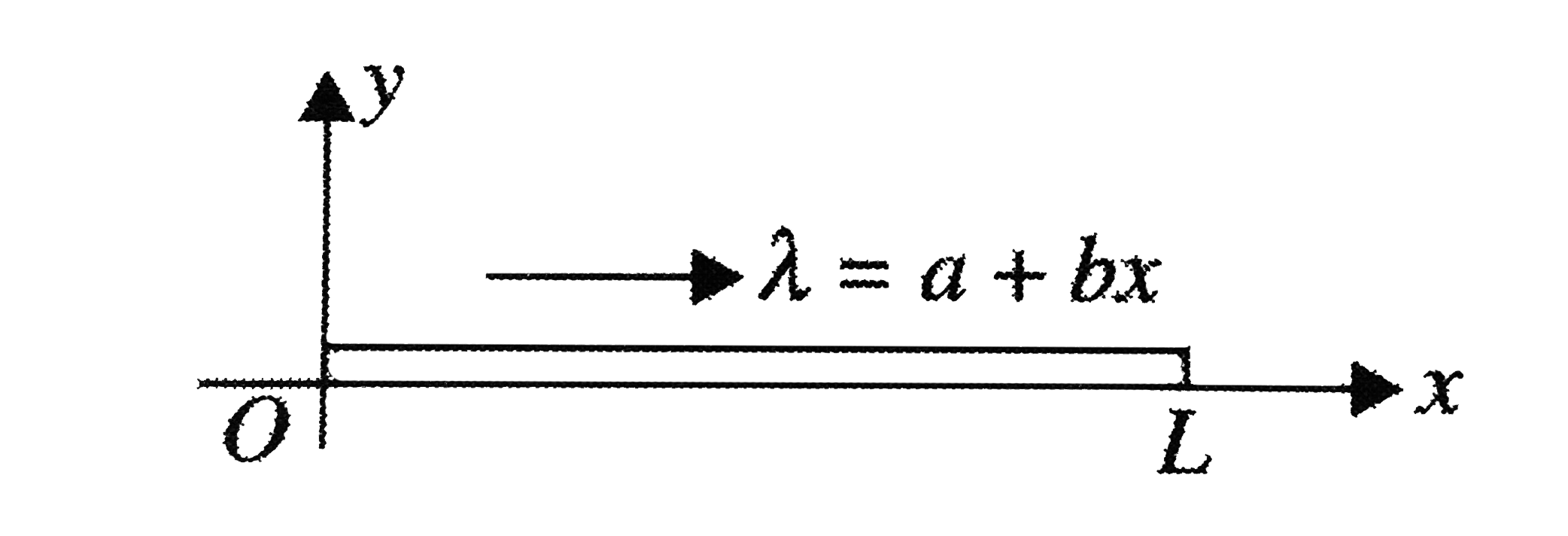A uniform thin rod AB of length L has linear mass density μ(x)=a+bxL, where x is measured from A. If the CM of the rod lies at a distance of (712L) from A, then a and b are related as :_
2a=b
a=2b
a=b
3a=2b
The correct Answer is:A
To solve the problem, we need to find the relationship between the constants a and b given that the center of mass (CM) of the rod lies at a distance of 712L from point A.
1. Define the linear mass density:
The linear mass density of the rod is given by:
μ(x)=a+bxL
where x is the distance from point A.
2. Determine the mass of a small segment:
Consider a small segment of the rod of length dx located at a distance x from A. The mass dm of this small segment is:
dm=μ(x)dx=(a+bxL)dx
3. Calculate the total mass of the rod:
The total mass M of the rod can be found by integrating dm from 0 to L:
M=∫L0dm=∫L0(a+bxL)dx
This can be split into two integrals:
M=∫L0adx+∫L0bxLdx
Evaluating these integrals gives:
M=aL+bL⋅L22=aL+bL2
Thus,
M=aL+bL2=L(a+b2)
4. Calculate the center of mass:
The center of mass xcm is given by:
xcm=1M∫L0xdm
Substituting dm:
xcm=1M∫L0x(a+bxL)dx
This can be expanded as:
xcm=1M(∫L0axdx+∫L0bx2Ldx)
Evaluating these integrals:
∫L0axdx=a⋅L22
∫L0bx2Ldx=bL⋅L33=bL23
Thus,
xcm=1M(a⋅L22+bL23)
5. Substituting for M:
Now substituting M:
xcm=1L(a+b2)(aL22+bL23)
Simplifying this gives:
xcm=L(a+b2)(a2+b3)
6. Setting xcm equal to 712L:
Set the expression for xcm equal to 712L:
L(a+b2)(a2+b3)=712L
Dividing both sides by L (assuming L≠0):
a2+b3a+b2=712
7. Cross-multiplying and simplifying:
Cross-multiplying gives:
12(a2+b3)=7(a+b2)
Expanding both sides:
6a+4b=7a+7b2
Rearranging terms:
6a+4b−7a−7b2=0
This simplifies to:
−a+4b−7b2=0
Multiplying through by 2 to eliminate the fraction:
−2a+8b−7b=0⟹−2a+b=0⟹b=2a
Final Result:
Thus, the relationship between a and b is:
b=2a
The linear mass density of the rod is given by:
μ(x)=a+bxL
where x is the distance from point A.
Consider a small segment of the rod of length dx located at a distance x from A. The mass dm of this small segment is:
dm=μ(x)dx=(a+bxL)dx
The total mass M of the rod can be found by integrating dm from 0 to L:
M=∫L0dm=∫L0(a+bxL)dx
This can be split into two integrals:
M=∫L0adx+∫L0bxLdx
Evaluating these integrals gives:
M=aL+bL⋅L22=aL+bL2
Thus,
M=aL+bL2=L(a+b2)
The center of mass xcm is given by:
xcm=1M∫L0xdm
Substituting dm:
xcm=1M∫L0x(a+bxL)dx
This can be expanded as:
xcm=1M(∫L0axdx+∫L0bx2Ldx)
Evaluating these integrals:
∫L0axdx=a⋅L22
∫L0bx2Ldx=bL⋅L33=bL23
Thus,
xcm=1M(a⋅L22+bL23)
Now substituting M:
xcm=1L(a+b2)(aL22+bL23)
Simplifying this gives:
xcm=L(a+b2)(a2+b3)
Set the expression for xcm equal to 712L:
L(a+b2)(a2+b3)=712L
Dividing both sides by L (assuming L≠0):
a2+b3a+b2=712
Cross-multiplying gives:
12(a2+b3)=7(a+b2)
Expanding both sides:
6a+4b=7a+7b2
Rearranging terms:
6a+4b−7a−7b2=0
This simplifies to:
−a+4b−7b2=0
Multiplying through by 2 to eliminate the fraction:
−2a+8b−7b=0⟹−2a+b=0⟹b=2a
Thus, the relationship between a and b is:
b=2a
Similar Questions
Find centre of mass of given rod of linear mass density λ=(a+b(xl)2) , x is distance from one of its end. Length of the rod is l.
View SolutionThe linear mass density of a thin rod AB of length L varies from A to B as λ(x)=λ0(1+xL). Where x is the distance from A. If M is the mass of the rod then its moment of inertia about an axis passing through A and perpendicualr to the rod is :
View SolutionA non-uniform wire of length l and mass M has a variable linear mass density given by μ=kx, where x is distance from one end of wire and k is a constant. Find the time taken by a pulse starting at one end to reach the other end when the tension in the wire is T.
View SolutionA rod length L and mass M is placed along the x-axis with one end at the origin, as shown in the figure above. The rod has linear mass density λ=2ML2x, where x is the distance from the origin. Which of the following gives the x-coordinate of the rod's center of mass?

View SolutionYou are given a rod of length L. The linear mass density is λ such that λ=a+bx. Here a and b are constants and the mass of the rod increases as x decreases. Find the mass of the rod

View SolutionTwo uniform thin rods each of length L and mass m are joined as shown in the figure. Find the distance of centre of mass the system from point O

View SolutionA rod of length L is placed along the x-axis between x=0 and x=L. The linear mass density (mass/length) ρ of the rod varies with the distance x from the origin as ρ=a+bx. Here, a and b are constants. Find the position of centre of mass of this rod.
View SolutionFind coordinates of mass center of a non-uniform rod of length L whose linear mass density lambda varies as lambda=a+bx, where x is the distance from the lighter end.
View SolutionThe linear density of a thin rod of length 1m lies as λ=(1+2x), where x is the distance from its one end. Find the distance of its center of mass from this end.
View SolutionAn insulting thin rod of length l has a linear charge density ρ(x)=ρ0xl on it. The rod is rotated about an axis passing through the origin (x=0) and perpendicular to the rod. If the rod makes n rotations per second, then the time averaged magnetic moment of the rod is :
View Solution
